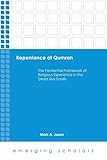Repentance at Qumran : the penitential framework of religious experience in the Dead Sea Scrolls / Mark A. Jason.
Series: Emerging scholarsPublication details: Minneapolis : Fortress Press, ©2015Description: xii, 289 pages ; 23 cmContent type:- text
- unmediated
- volume
- 9781451485301
- 1451485301
- Penitential framework of religious experience in the dead sea scrolls
| Item type | Current library | Shelving location | Call number | Status | Date due | Barcode | |
|---|---|---|---|---|---|---|---|
 Books
Books
|
BSOP Library | GC | BM645.R45 J31 2015 (Browse shelf(Opens below)) | Available | 00057925 |
Browsing BSOP Library shelves, Shelving location: GC Close shelf browser (Hides shelf browser)

|

|

|

|

|

|

|
||
| BM635.4 F33 1977 Biblical and post-Biblical defilement and mourning : law as theology / | BM645.F7 W21 2019 The liberating path of the Hebrew prophets : then and now / | BM645 L57 2006 Resurrection and the restoration of Israel : the ultimate victory of the God of life / | BM645.R45 J31 2015 Repentance at Qumran : the penitential framework of religious experience in the Dead Sea Scrolls / | BM651 V28f 2004 From Joshua to Caiaphas : | BM651 V28f 2004 c.3 From Joshua to Caiaphas : | BM654 St8 The Tabernacle of Israel : |
Includes bibliographical references (pages 253-280) and indexes.
Mark A. Jason offers a detailed investigation of the place of repentance in the Dead Sea Scrolls, addressing a significant lacuna in Qumran scholarship. Normally, when the belief system of the community is examined, "repentance" is usually taken for granted or relegated to a peripheral position. By careful attention to key texts, Jason establishes the importance of repentance as a fundamental way of structuring and describing religious experience within the Qumran community. Repentance was important not only for entry into the community and covenant but also for daily governance and cultic activities, and even for authenticating understanding of the end times. Jason shows, then, that repentance was a central and decisive element in shaping that community's identity and undergirded its religous experience from the start. Further, comparison with relevant texts from the Apocrypha and pseudepigrapha shows that the Qumran community represented a distinctive penitential movement in Second Temple Judaism.


